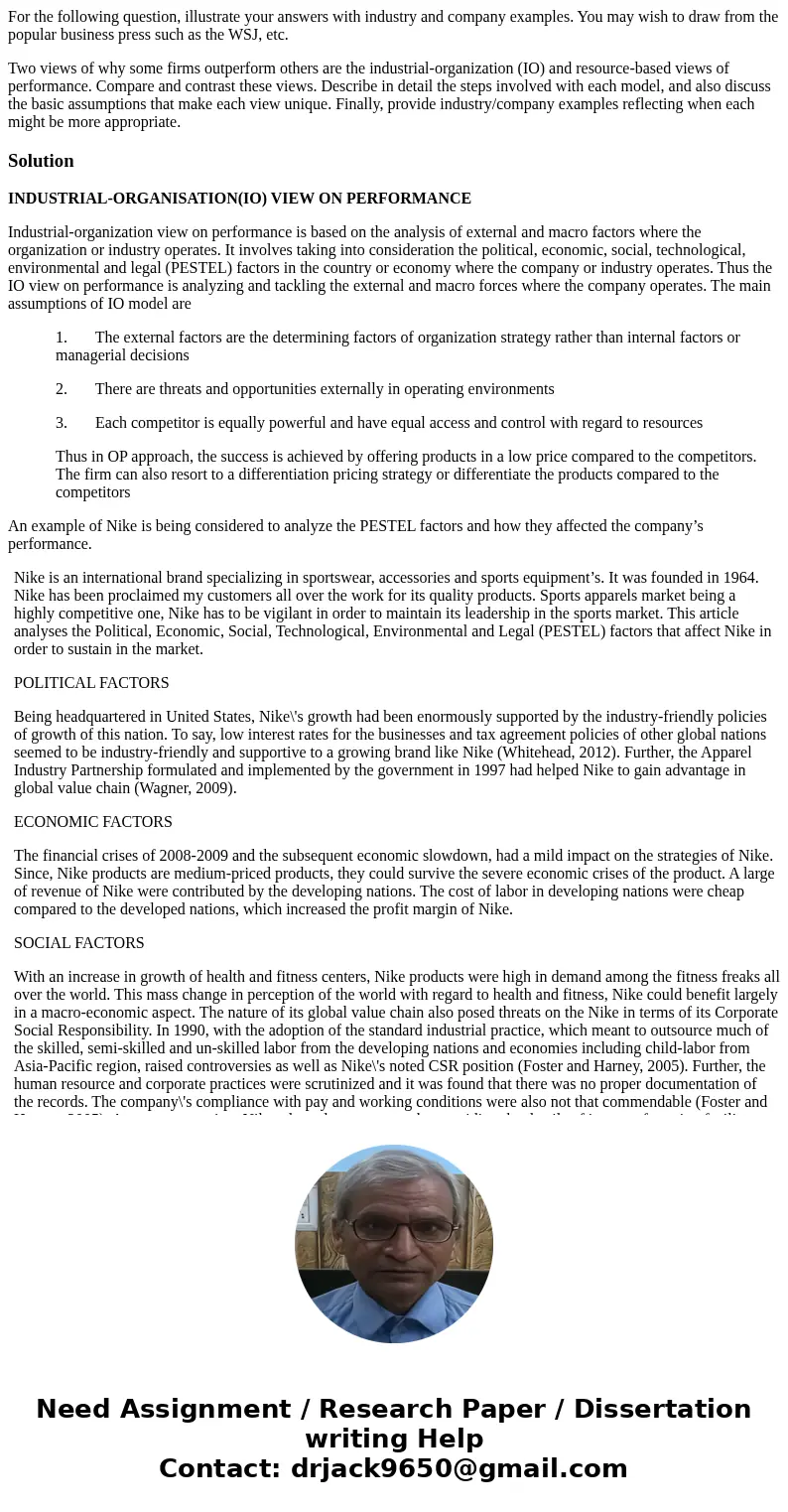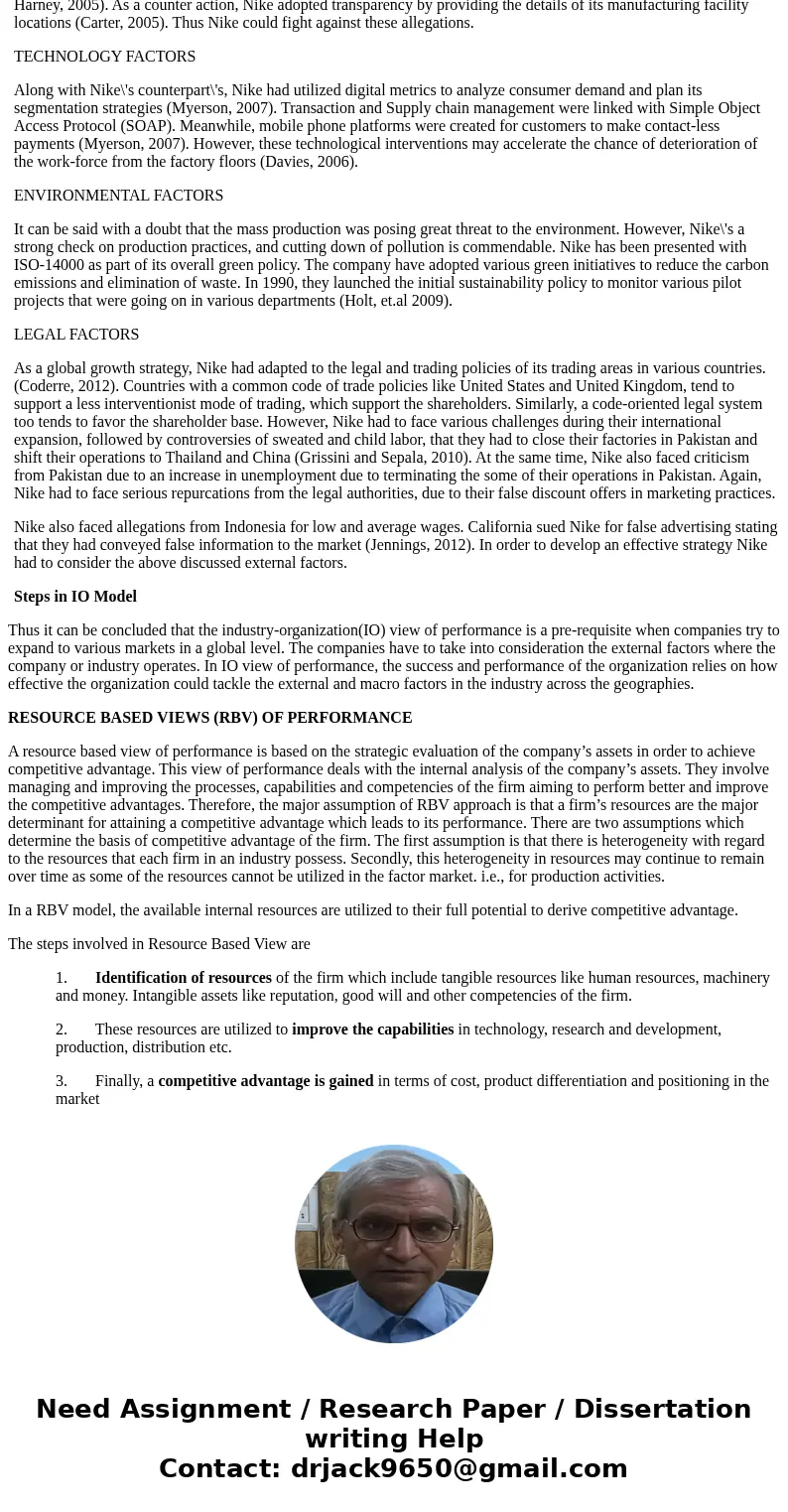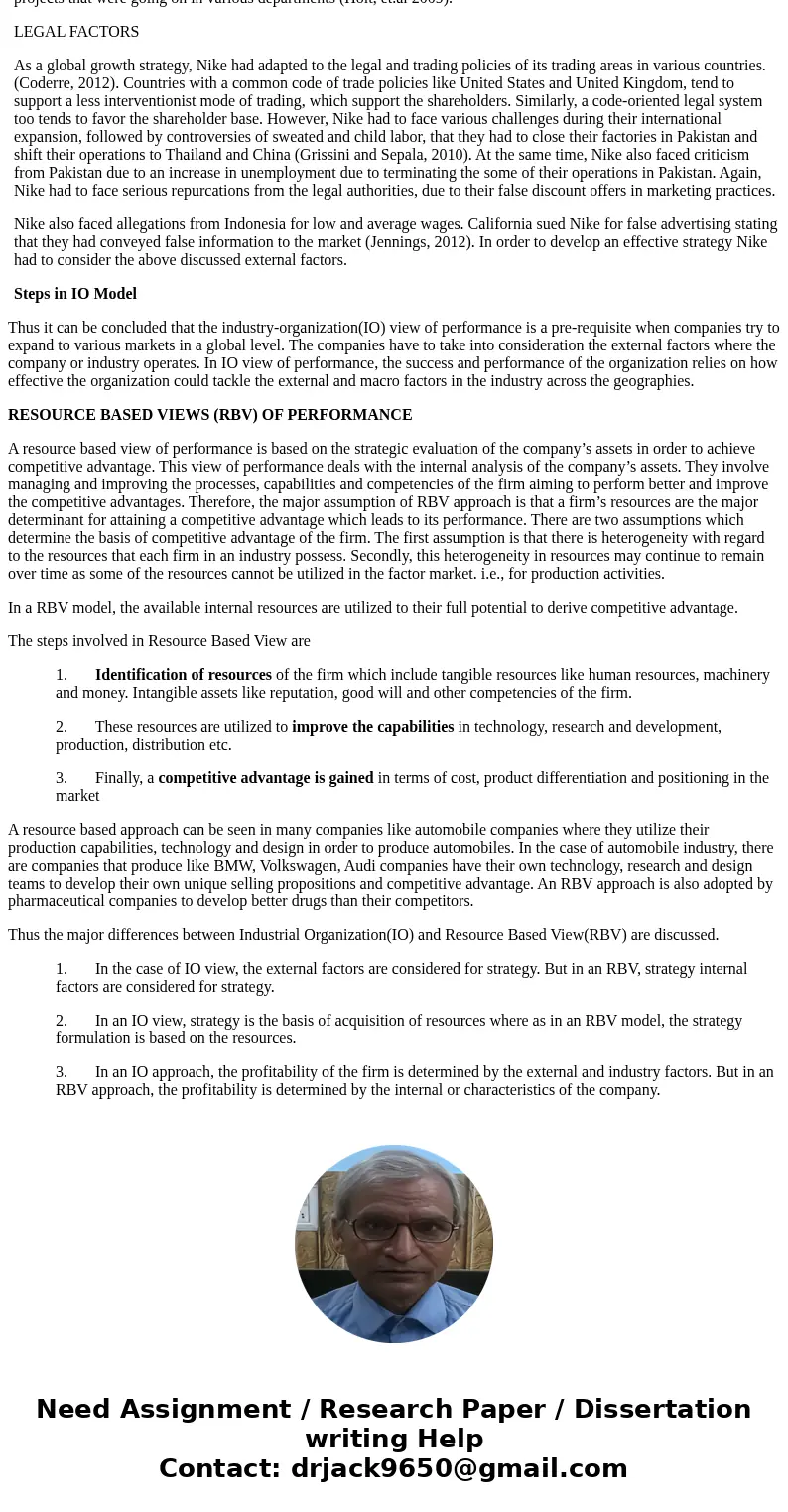For the following question illustrate your answers with indu
For the following question, illustrate your answers with industry and company examples. You may wish to draw from the popular business press such as the WSJ, etc.
Two views of why some firms outperform others are the industrial-organization (IO) and resource-based views of performance. Compare and contrast these views. Describe in detail the steps involved with each model, and also discuss the basic assumptions that make each view unique. Finally, provide industry/company examples reflecting when each might be more appropriate.
Solution
INDUSTRIAL-ORGANISATION(IO) VIEW ON PERFORMANCE
Industrial-organization view on performance is based on the analysis of external and macro factors where the organization or industry operates. It involves taking into consideration the political, economic, social, technological, environmental and legal (PESTEL) factors in the country or economy where the company or industry operates. Thus the IO view on performance is analyzing and tackling the external and macro forces where the company operates. The main assumptions of IO model are
1. The external factors are the determining factors of organization strategy rather than internal factors or managerial decisions
2. There are threats and opportunities externally in operating environments
3. Each competitor is equally powerful and have equal access and control with regard to resources
Thus in OP approach, the success is achieved by offering products in a low price compared to the competitors. The firm can also resort to a differentiation pricing strategy or differentiate the products compared to the competitors
An example of Nike is being considered to analyze the PESTEL factors and how they affected the company’s performance.
Nike is an international brand specializing in sportswear, accessories and sports equipment’s. It was founded in 1964. Nike has been proclaimed my customers all over the work for its quality products. Sports apparels market being a highly competitive one, Nike has to be vigilant in order to maintain its leadership in the sports market. This article analyses the Political, Economic, Social, Technological, Environmental and Legal (PESTEL) factors that affect Nike in order to sustain in the market.
POLITICAL FACTORS
Being headquartered in United States, Nike\'s growth had been enormously supported by the industry-friendly policies of growth of this nation. To say, low interest rates for the businesses and tax agreement policies of other global nations seemed to be industry-friendly and supportive to a growing brand like Nike (Whitehead, 2012). Further, the Apparel Industry Partnership formulated and implemented by the government in 1997 had helped Nike to gain advantage in global value chain (Wagner, 2009).
ECONOMIC FACTORS
The financial crises of 2008-2009 and the subsequent economic slowdown, had a mild impact on the strategies of Nike. Since, Nike products are medium-priced products, they could survive the severe economic crises of the product. A large of revenue of Nike were contributed by the developing nations. The cost of labor in developing nations were cheap compared to the developed nations, which increased the profit margin of Nike.
SOCIAL FACTORS
With an increase in growth of health and fitness centers, Nike products were high in demand among the fitness freaks all over the world. This mass change in perception of the world with regard to health and fitness, Nike could benefit largely in a macro-economic aspect. The nature of its global value chain also posed threats on the Nike in terms of its Corporate Social Responsibility. In 1990, with the adoption of the standard industrial practice, which meant to outsource much of the skilled, semi-skilled and un-skilled labor from the developing nations and economies including child-labor from Asia-Pacific region, raised controversies as well as Nike\'s noted CSR position (Foster and Harney, 2005). Further, the human resource and corporate practices were scrutinized and it was found that there was no proper documentation of the records. The company\'s compliance with pay and working conditions were also not that commendable (Foster and Harney, 2005). As a counter action, Nike adopted transparency by providing the details of its manufacturing facility locations (Carter, 2005). Thus Nike could fight against these allegations.
TECHNOLOGY FACTORS
Along with Nike\'s counterpart\'s, Nike had utilized digital metrics to analyze consumer demand and plan its segmentation strategies (Myerson, 2007). Transaction and Supply chain management were linked with Simple Object Access Protocol (SOAP). Meanwhile, mobile phone platforms were created for customers to make contact-less payments (Myerson, 2007). However, these technological interventions may accelerate the chance of deterioration of the work-force from the factory floors (Davies, 2006).
ENVIRONMENTAL FACTORS
It can be said with a doubt that the mass production was posing great threat to the environment. However, Nike\'s a strong check on production practices, and cutting down of pollution is commendable. Nike has been presented with ISO-14000 as part of its overall green policy. The company have adopted various green initiatives to reduce the carbon emissions and elimination of waste. In 1990, they launched the initial sustainability policy to monitor various pilot projects that were going on in various departments (Holt, et.al 2009).
LEGAL FACTORS
As a global growth strategy, Nike had adapted to the legal and trading policies of its trading areas in various countries. (Coderre, 2012). Countries with a common code of trade policies like United States and United Kingdom, tend to support a less interventionist mode of trading, which support the shareholders. Similarly, a code-oriented legal system too tends to favor the shareholder base. However, Nike had to face various challenges during their international expansion, followed by controversies of sweated and child labor, that they had to close their factories in Pakistan and shift their operations to Thailand and China (Grissini and Sepala, 2010). At the same time, Nike also faced criticism from Pakistan due to an increase in unemployment due to terminating the some of their operations in Pakistan. Again, Nike had to face serious repurcations from the legal authorities, due to their false discount offers in marketing practices.
Nike also faced allegations from Indonesia for low and average wages. California sued Nike for false advertising stating that they had conveyed false information to the market (Jennings, 2012). In order to develop an effective strategy Nike had to consider the above discussed external factors.
Steps in IO Model
Thus it can be concluded that the industry-organization(IO) view of performance is a pre-requisite when companies try to expand to various markets in a global level. The companies have to take into consideration the external factors where the company or industry operates. In IO view of performance, the success and performance of the organization relies on how effective the organization could tackle the external and macro factors in the industry across the geographies.
RESOURCE BASED VIEWS (RBV) OF PERFORMANCE
A resource based view of performance is based on the strategic evaluation of the company’s assets in order to achieve competitive advantage. This view of performance deals with the internal analysis of the company’s assets. They involve managing and improving the processes, capabilities and competencies of the firm aiming to perform better and improve the competitive advantages. Therefore, the major assumption of RBV approach is that a firm’s resources are the major determinant for attaining a competitive advantage which leads to its performance. There are two assumptions which determine the basis of competitive advantage of the firm. The first assumption is that there is heterogeneity with regard to the resources that each firm in an industry possess. Secondly, this heterogeneity in resources may continue to remain over time as some of the resources cannot be utilized in the factor market. i.e., for production activities.
In a RBV model, the available internal resources are utilized to their full potential to derive competitive advantage.
The steps involved in Resource Based View are
1. Identification of resources of the firm which include tangible resources like human resources, machinery and money. Intangible assets like reputation, good will and other competencies of the firm.
2. These resources are utilized to improve the capabilities in technology, research and development, production, distribution etc.
3. Finally, a competitive advantage is gained in terms of cost, product differentiation and positioning in the market
A resource based approach can be seen in many companies like automobile companies where they utilize their production capabilities, technology and design in order to produce automobiles. In the case of automobile industry, there are companies that produce like BMW, Volkswagen, Audi companies have their own technology, research and design teams to develop their own unique selling propositions and competitive advantage. An RBV approach is also adopted by pharmaceutical companies to develop better drugs than their competitors.
Thus the major differences between Industrial Organization(IO) and Resource Based View(RBV) are discussed.
1. In the case of IO view, the external factors are considered for strategy. But in an RBV, strategy internal factors are considered for strategy.
2. In an IO view, strategy is the basis of acquisition of resources where as in an RBV model, the strategy formulation is based on the resources.
3. In an IO approach, the profitability of the firm is determined by the external and industry factors. But in an RBV approach, the profitability is determined by the internal or characteristics of the company.



 Homework Sourse
Homework Sourse